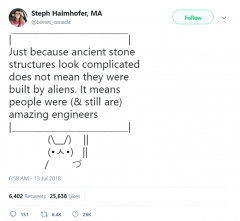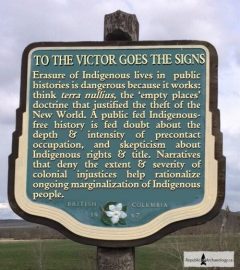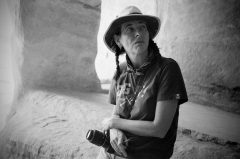Shannon Lectures – 2018
Shannon Lectures, 2018
Bad Archaeology
Convenor: Dr. Shawn Graham
About the series:
The History Department’s Shannon Lecture Series for 2018, will commence on October 12, 2018 with more details to be posted as they become available.
Archaeology tells us stories of the remote and not-so-remote past by placing careful emphasis on drawing out and understanding the contextual relationships of material remains with each other, their environment, and with us.
But what happens when archaeology goes bad? What happens when engagement with the material culture and this way-of-knowing is done in bad faith? Modern archaeology emerged from a colonialist setting where the heroic lone (male) adventure wrestled knowledge in exotic (to him) places. In many ways, the field has never shed that association, with its winking nods to Indiana Jones — ‘no we’re not all like him 😉 ’ — and the promise of adventure and heroism.
In this series of lectures, we explore some of the ways ‘bad archaeology’ has meaningful consequences for our everyday relationships with each other, especially here in a Canadian context. By understanding ‘bad’ archaeology, maybe we can begin to understand the power of a ‘good’ archaeology for our present day and age.
This public lecture series is made possible by the Shannon Fund, an endowment gifted by the late Lois M. Long, a long-time friend of the Department of History, in memory of her parents James Buchanan Long and Ida May (Davidson).
Donna Yates’ talk will be in the MacOdrum Library, Rm 252 (to the right of the main staircase, along the same wall as the Starbucks) at 2.30 pm. Reception to follow.
All subsequent talks are in Dunton 2017, from 1 to 2.30 pm. Reception to follow.
The speakers have all agreed to be recorded, and the videos will be available via the History Department’s Youtube Channel. Links to individual videos are provided below once they are available. Audio only (podcast) recordings are available on the Anchor.FM podcasting platform.
Friday, October 12, 2018
“Ancient Art and Modern Crime: How Stolen Antiquities End Up In Our Most Respected Museums“
Dr. Donna Yates (School of Social & Political Sciences, University of Glasgow)
MacOdrum Library (room 252), from 2:30-4:00 PM. Reception to follow.
Abstract

In 2011 a visitor walked into the Montreal Museum of Fine Arts and stole a 2500-year-old relief of a guard’s head valued at over $1.2 mil. In July of 2018, the New York Supreme court ordered that the sculpture, which had been seized by the District Attorney of New York from a London-based antiquities dealer, be returned to Iran. How the artefact was stolen from the famous archaeological site of Persepolis and ended up in Canada, and what happened after the piece was stolen again give us a glimpse of the dark underbelly of the art world. This is where high culture meets smuggling, desire, greed, and white-collar crime.
Many of our most respected museums house stolen antiquities. High-end auction houses and antiquities dealers sell loot on a daily basis. Upstanding and elite citizens freely engage in this criminal market. But unlike with most illegal commodities, trafficked antiquities can be openly bought and sold, and are often put on public display. How is this possible? Using the Persepolis relief as a case study, this lecture will discuss how research from criminology can be used to understand white collar crime in the art world.
Co-presented with the support of the Department of Law & Legal Studies.
View the recording on our Youtube channel.
Friday, October 19, 2018
“#InventedFantasies – Using Social Media to Talk About Pseudoarchaeology“
Steph Halmhofer (Bones, Stones, and Books)
Dunton Tower (room 2017), from 1:00-2:30 PM. Reception to follow.
Abstract

Skeletons of giants in British Columbia. People using psychic abilities to find proof that the empire of Atlantis included Nova Scotia. A cult in Quebec proposing aliens invented life on Earth. These sound like something you would find Dana Scully and Fox Mulder investigating in The X-Files. But I’m not Dana Scully, I’m an archaeologist. So why am I talking about aliens and giants? Because pseudoarchaeology, which includes the topics I’ve mentioned above, is a real concern facing both archaeologists and non-archaeologists. These theories can be found in books, television shows, and on social media but their negative impacts reach far beyond these pages and screens.
With rising popularity in social media and a currently combined total of around 440 million monthly users on Facebook, Twitter, and Instagram, it’s not difficult to imagine how quickly pseudoarchaeological theories can spread online. But just as we use our knowledge and trowels, social media can also be a powerful tool in the archaeological toolkit, a toolkit I want to share through this lecture. We’ll talk about what pseudoarchaeology is, focusing largely on Canadian examples, and how you can identify it. We’ll talk about the racism of pseudoarchaeology. We’ll also talk about how various media platforms are used to spread pseudoarchaeology. And finally, we’ll talk about how archaeologists and non-archaeologists can use social media to talk about and de-bunk pseudoarchaeology.
Co-presented with the support of the Department of Sociology and Anthropology.
View the recording on our Youtube channel.
Friday, November 9, 2018
“Good Intentions, Bad Archaeology: The uses and abuses of Canadian archaeology against Indigenous people“
Dr. Kisha Supernant (Department of Anthropology, University of Alberta)
Dunton Tower (room 2017), from 1:00-2:30 PM. Reception to follow.
Abstract

In the lands currently called Canada, archaeology is often used to tell stories about the history of this place, but often at the expense of Indigenous nations. Throughout our disciplinary history, archaeologists have positioned themselves as experts on and stewards of the past for the good of all, even though those pasts are sometimes not our own. In this talk, I explore how archaeology in Canada has been and continues to be part of the settler colonial state, centering knowledge from archaeologists and heritage practitioners rather than Indigenous peoples. I provide examples of how archaeological research has marginalized Indigenous voices, even when archaeologists have good intentions, and make some suggestions for how we can move toward a better archaeology for the future.
Co-presented with the support of the School of Indigenous & Canadian Studies.
View the recording on our Youtube channel
Friday, November 23, 2018
“There is no ‘net neutrality’ in digital archaeology“
Dr. Katherine Cook (Department of Anthropology, Université de Montréal)
Dunton Tower (room 2017), from 1:00-2:30 PM. Reception to follow.
Abstract

Colonisation, at its core, is the extraction of resources from those without power. What then gets extracted in digital colonialism and what does this have to do with archaeology in Canada? Considering the critiques, questions, and fallout regarding digital corporations, capitalism, and politics over the course of the past year, we are ever more acutely aware of the much darker underbelly of the digital world. Yet we still act as if digital technology is ‘the answer!’ to solving those ‘Great Challenges’ facing archaeology today, namely the lack of equity, inclusivity, access and the unwavering manifestations of (neo)colonialism. This discussion will consider the realities of digitally disrupting archaeology, the opportunities it presents but also the dangers it poses, to argue that not all data, not all audiences, and not all archaeologists are treated equally in digital practice. Digital archaeology will not save us from bad archaeology, so we must decolonize the digital first.
Co-presented with the support of the Carleton University Institute for Data Science.
View the recording on our Youtube channel
Friday, November 30, 2018
“The Pathways of Pots: The movement of Early Bronze Age vessels from the Dead Sea Plain, Jordan“
Dr. Morag M. Kersel (Department of Anthropology, DePaul University)
Dunton Tower (room 2017), from 1:00-2:30 PM. Reception to follow.
Abstract

What is the pathway of a pot? How do Early Bronze Age (3600–2000 BCE) pots from Jordan end up in Canadian institutions – and why does it matter? These particular pots are from sites along the Dead Sea Plain in Jordan, which have been identified as the “Cities of the Plain” mentioned in Genesis. One of the sites, Bab adh-Dhra’ is thought to be, by some, the original city of sin – biblical Sodom. “Who doesn’t want a pot from the city of sin?” declared one interviewee when I asked why they were purchasing (legally) what most would consider a fairly unattractive, non-descript pot. Over 15 years of investigation have led to interesting insights related to why individuals and institutions want to own artifacts from the Holy Land.
Tracing how pots move (both legally and illegally) involves archaeological survey, aerial investigations using unpiloted aerial vehicles, archival research, and ethnographic interviews in order to understand better the competing claims for these archaeological objects and the often deleterious effects of demand on the landscape. In this talk, I will look at how artifacts go from the mound to the market to the mantelpiece or museum vitrine and why this matters.
Co-presented with the support of the College of the Humanities.
View the recording on our Youtube channel.